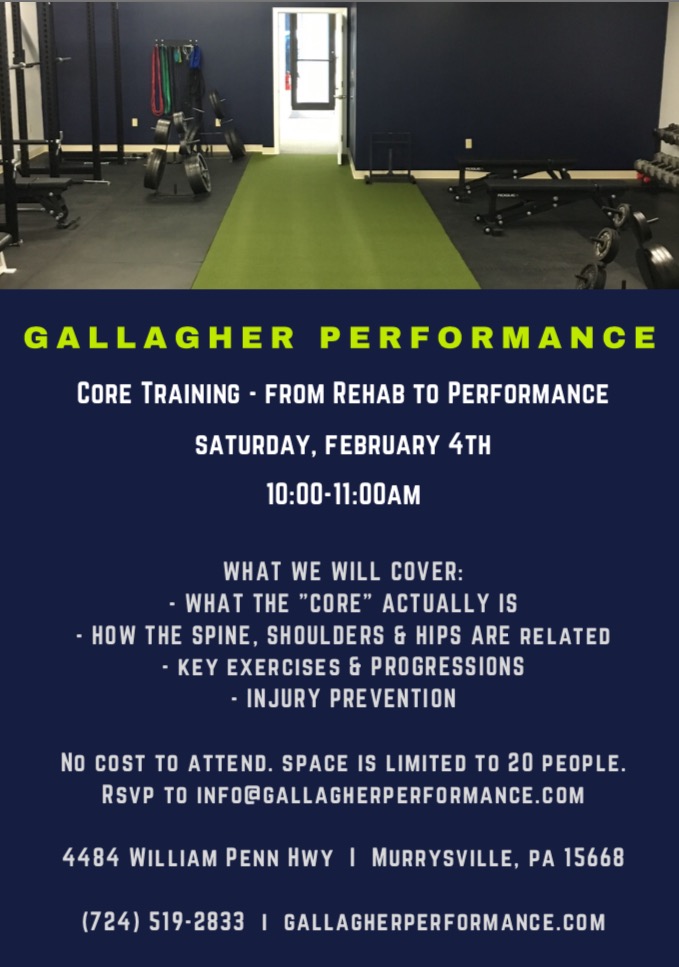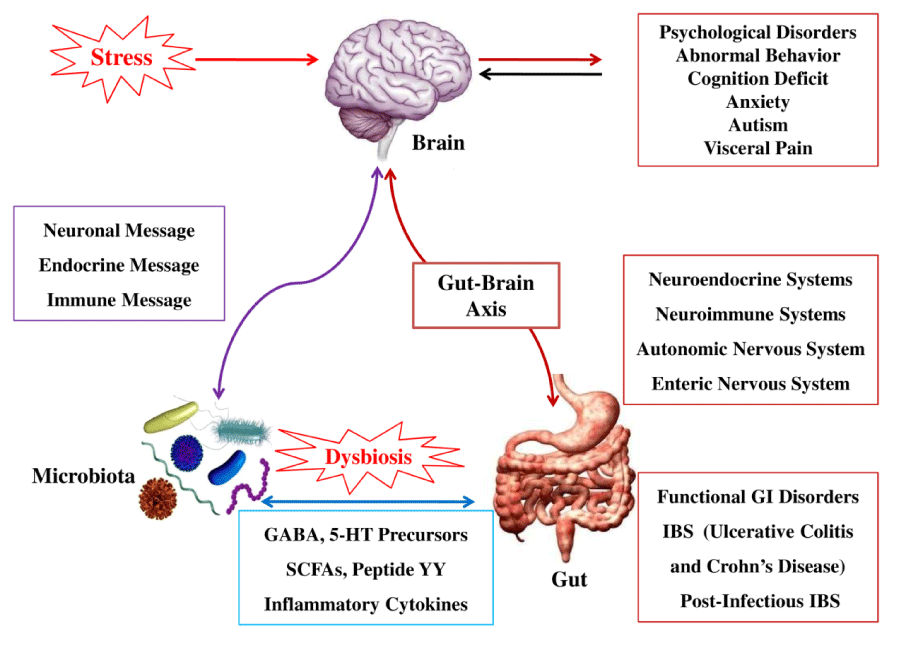About the Author: Kristin Gallagher has a Bachelor of Science in Nutrition from Indiana University of Pennsylvania and is currently a first-year student in the Physician Assistant program at Baldwin Wallace University. She has a special interest in dermatology, food allergies, GI disorders, and understanding the role gut health plays in health and disease. This paper has been reproduced with her permission.
Over 2,500 years ago Hippocrates had stated that “all disease begins in the gut.” It has been in the last several decades that this connection has been explored in great detail and proven that the gut serves a much bigger role than just nutrient extraction. In fact, this topic has gained popularity especially within in the past couple years. There have been several connections established between the gut and the brain and the ways in which they communicate with one another through the nervous, immune and endocrine systems (Patel).
So the question becomes: how exactly does our gut microbiome influence our brain health? By controlling our gut microbiome, how exactly can we affect our brain health and in what ways?
This topic is of great interest because of the correlations found between certain conditions and how the microbiome influences the development of them. If what Hippocrates hypothesized is true, it is of the greatest importance for one to understand how exactly they can influence their own gut microbiome because of the clear correlation seen between the gut and the development of different diseases. This is of clinical significance because of the influence it can have on recommendations and treatment options for certain diseases. If you were given the option to increase the wealth of your future, wouldn’t you want to explore how?
The Pathways Established
First it is important to understand the mechanisms behind how the gut and the brain are believed to interact and communicate with one another. The biggest influence in their communication involves the permeability of the gut. It should be noted that activity between the two systems via the vagus nerve has also been acknowledged as an influence (Stilling). Intestinal permeability has been established as the most important factor influencing microbial interactions with the rest of the body. It has also been established that having normal gut microbiota is essential to prevent harmful bacteria from colonizing. When normal gut microbiota is changed, by antibiotic therapy for example, it is noted that this allows pathogenic organisms to colonize the gut epithelium which leads to toxin production and thus focal inflammation, causing an increase in gut permeability. So what happens when gut permeability increases? The increase leads to more gut bacteria being translocated across the intestinal wall, resulting in the activation of inflammatory cytokines and the vagal system, both of which modulate the activity of the central and enteric nervous systems. These systems control the development of our cognitive, emotional and behavioral processes which would make sense for the various abnormalities seen with abnormal gut microbiota. Increased permeability also leads to the translocation of metabolic products such as lipopolysaccharide (LPS) or neuroactive peptides, also affecting the activity of the central and enteric nervous systems (Yarandi).
So, how do we control gut permeability?
Research has revealed that a large influencer of gut permeability is stress, be it acute or chronic in nature (De Palma). It has been observed that stress reduces water secretion and increases ion secretion in the intestine, which affects the physical barrier of the gut. Stress not only directly affects the permeability of the gut but it also directly changes the content of the gut microbiota itself. Controlling stress, as well as other factors that have been seen to change gut permeability as well as the gut microbiota itself, may in fact directly control the extent of gut permeability (Stilling).
Additionally, it is important to understand how these changes are relayed to the brain. What serves as the communication between the gut and the brain? As stated earlier, it is under the influence of the vagus nerve but notably, the hypothalamic-pituitary-adrenal (HPA) axis is also a crucial pathway between the two. The HPA axis is a key stress regulatory system in the CNS and it is noted that gut microbes modulate the stress response and this pathway directly. Most of the studies regarding this pathway that have been completed up until this point have focused on using germ-free (GF) mice. What they have seen is that GF mice have an exaggerated HPA response to stress, but by injecting these mice with B. infantis, it corrects the abnormal response seen (Yarandi). From this information, the general understanding is that the content of our microbiota directly influences the integrity of our intestinal permeability and when this is affected, it allows for more influence of bacteria over the CNS and ENS thus establishing the relationship seen between our gut and our brain. Many other specific organisms, out of the 3.3 million non-human genes found in the human gut, have also been explored as well (Stilling).
The Importance of Infancy
Much of the literature on this topic looks at how the gut is influenced from birth. There are several environmental factors that have been associated with influencing the gut microbiome contents, these factors including: mode of delivery (vaginal or caesarean section), breast-feeding, diet, disease, status of the immune system, age, pharmacological treatments (especially antibiotics) and physical activity. There has been a noted correlation in that babies delivered by caesarean section, a number that has dramatically increased over the past several years, with an increase in autoimmune diseases and allergies being seen as well (Stilling). It has also been observed that babies not delivered vaginally also are seen to have a greater chance of developing allergies, asthma and diabetes later in life. Other findings noted include that breastfed babies show a decrease in harmful gut bacteria, such as Bifidobacterium, as compared to formula-fed babies. Studies reveal that formula-fed babies have an increase in harmful bacteria such as coliforms, Bacteroides and Clostridium difficile (Clarke). It is important to realize that the human intestinal tract is basically sterile at birth. It is then immediately colonized and exactly the way in which it is colonized is essential for the development of the baby. Maternal separation is also noted to play a role in inducing long-lasting hyperactivity of the HPA axis, increasing anxiety-like behavior, visceral hypersensitivity, intestinal permeability and altering the cholinergic activity in the gut (De Palma). Visceral hypersensitivity has been found to be correlated with irritable bowel syndrome and the administration of probiotic therapies has been shown to reverse this in animal and human trials (Stilling). The general idea is that when we are born, there is a window of opportunity for influencing the gut microbiota and that the presence or absence of any specific microbe during this window can have a notable, lasting effect (Yarandi).
The Diseases Correlated
With all this talk about the importance of the gut microbiota for normal pathway functioning and signaling, as well as how important it is in the first few years of life for our future leads us to the question: why should we care? There are a number of diseases that have been correlated with altered gut permeability and gut microbiota. With the increasing number of individuals being diagnosed with autism spectrum disorders (ASD), it is interesting to note the differences in the gut in these individuals as well. It is seen that they have abnormal gut microbiota (De Palma) as well as increases in bacteria from the Clostridium species and decreases in the Bacteroides species. It is postulated that this is why these patients often benefit from gluten free and casein free diets. It was also seen that ASD patients administered oral vancomycin, to help with their gastrointestinal (GI) issues, not only experienced a decrease in their GI symptoms but had an improvement in their autistic behavior as well (Yarandi). Other diseases that have been associated with abnormal gut microbiota include inflammatory bowel disease, irritable bowel syndrome, celiac disease, schizophrenia, depression, obesity, metabolic syndrome, anxiety, multiple sclerosis, Alzheimer’s disease and Parkinson’s disease (Foster). There are many specific bacterial associations seen in these different diseases but the foundation of each is dysbiosis, the disadvantageous alteration in microbial composition (Stilling). It is believed that dysbiotic changes in gut microbiota is what leads to disease states, behavioral changes, and changes in brain function (Foster). All of this poses a larger question as to the root of the problem; is it the changes in gut composition that cause diseases or the diseases that cause changes in the composition (Stilling)? The research still seeks to find an answer.
Conclusion
Of all the themes seen throughout the literature, these three were clearly the ones discussed the most. There are many more correlations seen and the evidence for them is still being built upon. The evidence stands clear that a diverse gut microbiome is beneficial to health and that changes in the microbiome directly affect behavior; the microbiome regulates nervous system development, our stress response, anxiety and appetite levels as well as our circadian rhythms. Clearly established in the literature is the obvious connection between the gut and the brain, making clear that a healthy microbiota is necessary to maintain a healthy nervous system (Mu).
Looking back to my question of inquiry, the literature proves that our gut microbiome does in fact influence our brain health as well as disease states and behavior. The research that has been done so far on this topic has just barely scratched the surface and further research on it is a necessity, especially honing in on studies in humans because most research up until now has been done utilizing mice and rats. There is much more to be said on this topic and I could only expose just the beginning of some of the findings to this date. This is just the beginning of a topic that holds a bright future for potentially changing medicine in a drastic way. Someday soon, we may be able to prove Hippocrates hypothesis to be true indeed – that all disease does in fact start in the gut.
Works Cited
Clarke, G., O'Mahony, S. M., Dinan, T. G., & Cryan, J. F. (2014). Priming for health: gut microbiota acquired in early life regulates physiology, brain and behaviour. Acta Paediatrica (Oslo, Norway: 1992), 103(8), 812-819. doi:10.1111/apa.12674
De Palma, G., Collins, S. M., Bercik, P., & Verdu, E. F. (2014). The microbiota-gut-brain axis in gastrointestinal disorders: stressed bugs, stressed brain or both?. The Journal Of Physiology, 592(14), 2989-2997. doi:10.1113/jphysiol.2014.273995
Foster, J. A., Lyte, M., Meyer, E., & Cryan, J. F. (2016). Gut Microbiota and Brain Function: An Evolving Field in Neuroscience. International Journal of Neuropsychopharmacology, 19(5), pyv114. http://doi.org/10.1093/ijnp/pyv114
Mu, C., Yang, Y., & Zhu, W. (2016). Gut Microbiota: The Brain Peacekeeper. Frontiers in Microbiology, 7, 345. http://doi.org/10.3389/fmicb.2016.00345
Patel, K. (2016). What have we learned about nutrition in the past 5 years? Retrieved November 13, 2016, from https://examine.com/nutrition/an-interesting-5-years/
Stilling, R. M., Dinan, T. G., & Cryan, J. F. (2014). Microbial genes, brain & behaviour - epigenetic regulation of the gut-brain axis. Genes, Brain, And Behavior, 13(1), 69-86. doi:10.1111/gbb.12109
Yarandi, S. S., Peterson, D. A., Treisman, G. J., Moran, T. H., & Pasricha, P. J. (2016). Modulatory Effects of Gut Microbiota on the Central Nervous System: How Gut Could Play a Role in Neuropsychiatric Health and Diseases. Journal of Neurogastroenterology and Motility, 22(2), 201–212. http://doi.org/10.5056/jnm15146
More related reading:
https://gallagherperformance.com/why-poor-recovery-will-make-you-sick-sad-and-weak/





